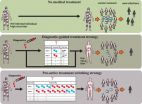(Press-News.org) If you're in the market for a new car, and especially if you have a trade-in, the latest research from the USC Marshall School of Business marketing department suggests you aren't getting the deal you think you are getting.
New research from USC Marshall School of Business associate professors of marketing Anthony Dukes and Sivaramakrishnan Siddarth shows that a consumer with a trade-in actually forks over more money to the dealer than consumers without a trade-in.
"The Informational Role of Product Trade-Ins for Pricing Durable Goods" is forthcoming in the Journal of Industrial Economics.
Dukes and Siddarth co-authored the study with Jorge M. Silva-Risso at the University of California, Riverside, and Ohjin Kwon at Concordia University. Lead author Kwon '10 has a Ph.D. in marketing from Marshall.
Making Assumptions
The research theorizes that sellers of durable goods for which dealers accept trade-ins--cars, boats, home appliances and musical instruments--can utilize inferences about the buyer's willingness to pay based not only on his or her decision to trade in the old good, but also on its characteristics. The researchers focused on automobiles, testing their theoretical model with data from new-car transactions in the premium midsize sedan category between 2001 and 2005.
The results indicate that dealers infer a higher willingness to pay, and so charge higher prices to consumers who trade in a used vehicle than to those who do not.
Brand loyalty? That will cost you too.
Dealers charge even higher prices to consumers who trade in used cars similar to the new one, the researchers found.
Buyers with a trade-in pay an average of $990 more than those who do not trade in their used cars, according to the research. In addition, a buyer pays an additional $150 more if the trade-in is of the same make as the new car, and another $64 more if it is the same make and model.
"The most important finding of our research is that your decision to trade in your old car tells the dealer something about you and your insensitivity to price," said Dukes. "It might be why car salespeople often ask you, soon after stepping into a showroom, whether you're trading in your old car -- even before you discuss terms of the new car."
"For example, if you're buying a new Honda and trading in an old Honda, the dealer may infer that you were happy with your old Honda and probably are not considering Toyota, Nissan, or any other competitive brand," Dukes explained.
What is a consumer to do? "Consider hiding from the salesperson the fact that you have a trade-in until after you reach the price of the new car," said Dukes. "Our research suggests you will receive a lower price."
INFORMATION:
Results to be published in the Journal of Family and Economic Issues suggest that having short-term household debt -- credit cards and overdue bills -- increases depressive symptoms. The association is particularly strong among unmarried people, people reaching retirement age and those who are less well educated, according to a new study by lead author Lawrence Berger of the University of Wisconsin-Madison.
These are the first results to show the impact of different types of debt on depression and their effects on different sectors of the US population. Little evidence ...
Scientists are using a variety of buoys and autonomous underwater vehicles to record and archive sounds from marine mammals and fish species in the western North Atlantic through a new listening network known as the U.S. Northeast Passive Acoustic Sensing Network (NEPAN).
Stretching from the northern Gulf of Maine to the New York Bight in the northwest Atlantic Ocean, NEPAN provides year-round, long-term information on the presence and physical distribution of vocal whales, dolphins and porpoises and some fish species. The archived and near-real-time data comes from recorders ...
Researchers at Aalto University (Finland) and Amherst College (USA) have observed a point-like monopole in a quantum field itself for the first time. This discovery connects to important characteristics of the elusive monopole magnet. The results were just published in Science magazine.
The researchers performed an experiment in which they manipulated a gas of rubidium atoms prepared in a nonmagnetic state near absolute zero temperature. Under these extreme conditions they were able to create a monopole in the quantum-mechanical field that describes the gas.
'In this ...
LA JOLLA -- A study tying the aging process to the deterioration of tightly packaged bundles of cellular DNA could lead to methods of preventing and treating age-related diseases such as cancer, diabetes and Alzheimer's disease, as detailed April 30, 2015, in Science.
In the study, scientists at the Salk Institute and the Chinese Academy of Science found that the genetic mutations underlying Werner syndrome, a disorder that leads to premature aging and death, resulted in the deterioration of bundles of DNA known as heterochromatin.
The discovery, made possible through ...
HOUSTON - (April 30, 2015) - With the Millennium Development Goals established by the United Nations in 2000 coming to an end in 2015, and the new Sustainable Development Goals now in the works to establish a set of targets for the future of international development, experts at Baylor College of Medicine have developed a new tool to show why neglected tropical diseases, the most common infections of the world's poor, should be an essential component of these goals.
Using World Health Organization data for the number people at risk of parasitic worm infections in each ...
A detailed study of marine animals that died out over the past 23 million years can help identify which animals and ocean ecosystems may be most at risk of extinction today, according to an international team of paleontologists and ecologists.
In a paper to be published in the May 1 issue of the journal Science, researchers from the University of California, Berkeley, and other institutions report that worldwide patterns of extinction remained remarkably similar over this period, with the same groups of animals showing similar rates of extinction throughout and with a ...
Demand for seafood from wild fisheries and aquaculture around the world has nearly doubled over the past four decades. In the past several years, major retailers in developed countries have committed to source their seafood from only sustainably certified fisheries and aquaculture, even though it is not clear where that supply will come from.
A team of researchers led by the University of California, Davis, has focused its attention on fishery improvement projects, or FIPs, which are designed to bring seafood from wild fisheries to the certified market, with only a promise ...
HIV-1 continues to spread globally. While neither a cure, nor an effective vaccine are available, recent focus has been put on 'treatment-for-prevention', which is a method by which treatment is used to reduce the contagiousness of an infected person. A study published this week in PLOS Computational Biology challenges current treatment paradigms in the context of 'treatment for prevention' against HIV-1.
Sulav Duwal, Max von Kleist and their collaborators develop and employ optimal control theory to compute and assess diagnostic-guided vs. pro-active treatment strategies ...
Proteins inside a cell are in constant motion, changing shape continuously in order to carry out their functions. In addition, their multiple component atoms each have individual patterns of motion, making the entire protein a system of non-stop highly complex movement. Understanding how a protein moves is the key to developing drugs that can efficiently interact with it. But because of this complexity, protein motion has been notoriously difficult to study. Scientists at EPFL, IBS-Grenoble, and ENS-Lyon, have developed a new method for studying protein motion by first ...
The fossil record helps to predict which kinds of animals are more likely to go extinct. When combined with information about hotspots of human impacts and climate-change predictions, Smithsonian scientists and colleagues pinpoint animal groups and geographic areas of highest concern for marine conservation in the May 1 issue of Science magazine.
"Just as some groups of people are more prone to health problems like diabetes or heart disease, we can tell from the fossil record which groups of animals are naturally more likely to go extinct," said Aaron O'Dea, paleontologist ...




